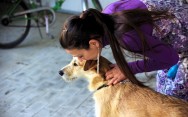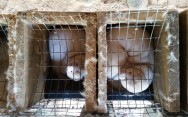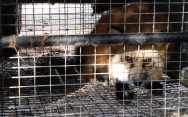Blog Archives
Home -
Posts tagged "animal rights" (Page 2)
Using hidden cameras in agricultural facilities is still one of the best ways to reveal the horrific cruelty of industrial agriculture. This is why states continue to pass “ag gag” laws to restrict and punish any exposure of practices at agricultural facilities.
An animal rights group, Mercy for Animals, used hidden surveillance to protest Senate Bill 16 in Kentucky, which aims to criminalize the use of recording equipment such as drones, cameras, video recorders, audio recorders etc. inside concentrated animal feeding operations. In doing so they exposed exactly the reason why criminalizing these practices shields violence and cruelty from the public eye.
Workers are known to abuse animals horribly at industrial agriculture facilities, and the farms that Mercy for Animals exposed were no exception. The group released videos showing workers kicking, stepping, throwing and stuffing chickens into cages for transport. The farms are described as contract farms providing chicken to Pilgrim’s Pride, one of the largest chicken producers in the United States.
Large industrial farms continue to claim that animals are killed humanely, and any problems are the result of bad apples. But the scale of cruelty and killing at these farms reveals that it is the norm for workers to dehumanize animals and abuse them before killing them. This is part of a psychological process that is not separate from industrial farming, it’s normalized by workers exposed to violence every day as part of their job. Animal rights groups continue to expose these conditions, and the farming groups protest that the problem is the individuals involved, and not the industrial scale of the killing operation itself.
One of the key tools animal rights activists have at their disposal is drones, which are cheap and capable of recording poor conditions, animal abuse and illegal hunting. Footage captured by drones has led to many successful campaigns on behalf of animals.
If blocking surveillance of animal rights abuses were just protecting private property, why is it that industrial farming interests are always behind these laws? The cruelty that we see on footage obtained by animal rights groups is clearly a fraction of what actually exists. We must continue to fight for the right to expose horrific cruelty and the lies of the industrial farming industry.
The Miami-Dade commission has served eviction papers to the Dolphin Company, the owners of the Miami Seaquarium, after the company presided over severe neglect and poor conditions for animals in their care for many years. The Miami-Dade commission has ordered the Dolphin Company to vacate the premises by the 21st of April 2024. The commission’s letter cited violations of the lease agreement which included “not just a default, but a complete disregard for the safety of the animals housed on the premises.”
The history of the park is one of sadness, neglect, cruelty and enslavement for animals. The park’s history as an amenity for humans on the other hand, is one in which it enriched a private company and in the park’s earlier years was the third largest contributor to Miami-Dade County’s revenue through lease and tax payments.
The park is behind at least $180,000 in rent, which is one reason for the Miami-Dade commission’s decision. The decision was also motivated by the park’s numerous USDA violations and the loss of its Humane Society of America certification. Animal rights organizations have spoken out against the facility for years, in some cases managing to rescue animals, such as a pair of manatees, Romeo and Juliet. At least 120 dolphins and whales have died in captivity at the park. A dolphin named Sundance recently died shortly after a USDA inspection, where it was noted that the dolphin had “signs of gastric distress.” Federal inspections showed that the park’s infrastructure was deteriorating. A dolphin was found with a two-inch nail in its throat. Another dolphin was found with a broken metal bolt in its mouth.
One of the park’s major problems was that it couldn’t keep staff. Multiple staff resigned at the conditions of the park, and some alleged retaliation when they tried to speak up against the conditions. Due to money problems and difficulty retaining staff, the park didn’t have enough veterinarians to attend to the animals. The veterinary lab lacked basic tools and the animals were denied surgery, including a sea lion with eye pain, who stopped eating. One of the park’s animals, an Orca named Tokitae, gained recognition for all the wrong reasons, because the tank she was forced to live in was the nation’s smallest tank. Since coming to the world’s attention, Toki, also known as Lolita, has died.
Why did it take so long for the neglect to be put to an end? There is a bureaucratic process that has to happen to hold such facilities accountable. The park was known to be an unhealthy and cruel place for animals to live for decades. Attention wasn’t focused on the park soon enough because parks like these were for many years deemed to be acceptable entertainment and education for humans. The roles of animals at these parks, who are forced to perform for humans, and who are kept in restrictive conditions and separate from family members, were not questioned. It’s now time to question the rationale for keeping animals in these facilities. There may be some conservation reasons for keeping some species of animals captive, but even then, keeping animals in captivity, where they can be exploited, should be viewed with public skepticism and treated as a last resort.
|
Tags: Animal Neglect,
animal rights,
Animals in Captivity,
Dolphin,
Kevin Boileau,
Marine Animals,
Marine Park,
Miami Seaquarium,
Nazarita Goldhammer,
Orca,
Toki the Orca,
Whale
The death of New York’s beloved owl Flaco was a tragic event that drew attention to the way in which a city-dwelling bird’s life can be tragically cut short. The cause of death? It seems that Flaco died after a collision with a building. Flaco’s death was also attributed to 4 kinds of rat poison that were found in his system. Additionally, he was also found to have a severe case of “pigeon herpesvirus” from eating feral pigeons. Toxicology also showed a breakdown of the pesticide DDT, but the levels of the pesticide were not significant enough to cause his death. The rodenticide and virus were both capable of causing severe illness, according to Dr. Paul Calle, chief veterinarian for the Wildlife Conservation society, though it’s unclear which one was responsible for the bird’s death. Flaco’s ultimate cause of death, a collision with a building, would likely have been caused by the bird flying disoriented while he was suffering from illness and poisoning.
Bird collisions are an incredibly common cause of death for birds. They are the second most common cause of death after domestic cats. Collisions with building glass kill between 90,000 and 230,000 migrating birds in New York City each year, according to Audubon NYC’s research. In addition, birds that dwell in big cities have much more contend with, as they have to deal with toxic pesticides commonly used by private homeowners in big cities like New York City. Wild Bird Fund director Rita McMahon said that rodenticide is to blame for 84% of the deaths of birds that they encounter, and that the poisons can stay in a bird’s system for up to 100 days.
Flaco was a Eurasian eagle-owl that escaped the Central Park Zoo after someone cut his cage’s stainless steel mesh. The Zoo attempted to recapture Flaco, but he began to improve his hunting skills and gain independence, so the Zoo were not able to entice him back with food.
Sightings of Flaco began to be common. New Yorkers celebrated the bird’s presence and his successful bid to live in the wild. The Central Park Zoo cautioned that Flaco might be endangered by eating a poisoned rodent or might prey on sensitive species. Flaco seemed to be doing well, but then in February 2024, a fallen owl was reported to the Wild Bird Fund, and the owl was confirmed to be Flaco. New Yorkers mourned his death and created a memorial to Flaco at the base of his favorite tree in Central Park.
Flaco’s death was a tragedy, but his life was an inspiration. Though he was safe at the Zoo, he followed his natural instinct for freedom and lived a life of independence before he died. His death has focused attention on the issue of bird safety in cities, and what humans can do to make cities safer for birds. New York Senators have renewed a push to pass the Dark Skies Act and renamed the Bird Friendly Buildings Act the FLACO Act. These pieces of legislation will require state owned buildings to make bird friendly provisions in their architecture and to reduce lighting at night, which has been shown to disorient night migrating birds that may fly into cities and die by collision. Birds face a host of threats in cities, including bird collisions, habitat loss, and poisoning by pesticide or rodenticide.
Flaco the owl was an animal who stood out and reminded city dwellers that animal lives have meaning. With the publicity around his death, now is a good time to push local legislators to take steps to introduce legislation to make cities more bird friendly. You can also reach out to your local bird conservation societies to see how you can join the effort to protect birds in cities.
In an exciting breakthrough for research in animal communication, the SETI institute managed to
have the first ever conversation with a humpbacked whale. The SETI institute began as a NASA
research program to understand and search for life beyond earth. The Whale-SETI team is using the
mathematics of information theory to understand terrestrial, non-human communication as a way
to develop filters to apply to any communication with extraterrestrial life.
Humpback whales are social and intelligent creatures who make tools and communicate with songs
and social calls. The Whale-SETI team has been studying humpback whale communication, which
include “contact calls” that whales use to communicate their presence to other whales. The team of
scientists from the SETI Institute, UC Davis and the Alaska Whale Foundation played the contact calls
into the sea via an underwater speaker, and a humpback whale named Twain approached and
circled the team’s boat while responding in a style that matched the original contact signal. The
researchers managed to have a 20 minute conversation with Twain. It is the first known
“conversation” between humans and humpback whales. Humpback whales also display non-audio
communicative behavior when they blow bubble rings in the presence of humans.
Whale SETI may be viewed as a springboard for communicating with extraterrestrial life. However
communication with animals could have more immediate benefits for animals in our world, right
now. Whales are one of the marine creatures who are profoundly affected by human activity. Whale song is disrupted by the noise of ships. If we can communicate with non-human animals our decision making should consider them as equal participants.
Humans have erroneously viewed human communication as synonymous with superior intelligence.
Without the ability to communicate with other animals and with a so-called superior intelligence
human activity has rampaged throughout animal habitats without the consent of animals. Every step
towards understanding animal intelligence and communication provides further evidence that these
assumptions are wrong. Scientific knowledge should not dictate our respect for non-human animals,
however scientific discovery can provide a basis for progressive animal rights policy and zero
tolerance for cruelty towards non-human lives.
|
Tags: Animal Communication,
Animal Habitats,
Animal Intelligence,
animal rights,
Humpbacked Whale,
Kevin Boileau,
Marine Animals,
Nazarita Goldhammer,
Transhumanist,
Whale Communication,
Whale Song
South Korea’s dogmeat trade has long been a national source of shame, especially to younger
people, who have developed more progressive views about animals. Pets such as domestic dogs and
cats have become more popular, changing people’s views of dogs as disposable animals that can
be farmed for meat. The dogmeat trade has been dying out on its own, but it has lingered on. The
dog meat trade is incredibly cruel and dogs are often killed in extremely painful ways. Dogs are kept
caged and suffer cruel conditions where they see other dogs killed. As social animals, this must be
unbearable to them.
Last year, South Korea’s parliament voted near unanimously to ban the dog meat industry. The law
takes effect in 2027 and will ban any future slaughter breeding and sale of dogs for dog meat.
The consumption of dog meat is based on historical traditions and unscientific beliefs about the
health benefits of dog meat. One of the most horrifying things about these traditions is that dogs are
deliberately tortured before death because of the belief that the adrenaline levels in the animal will
contribute to health benefits. Although dog meat was traditionally eaten in South Korea in the past,
there is evidence that this was not widespread and it became more popular due to false beliefs
about its effects on virility in older men. Animals have long been tortured because of human crazes
and the dog meat industry is a particularly cruel example. Not only are animals farmed for dog meat
but also abandoned pets are collected from the streets and slaughtered for the dog meat trade.
Activists inside and outside of the countries where dog meat is eaten have protested the practice.
On the other hand, condemning the practice has been associated with anti-Asian racism in incidents
in the US where restaurants have been falsely accused of selling dog meat. Consuming dog meat is
not “barbaric” because of a country’s culture, it is barbaric because humans are capable of extreme
cruelty towards animals when it is in their own interests.
Although it’s positive that dogs will be protected from this horrific cruelty in the future, the dog
meat ban should not draw attention away from the suffering of all animals such as cows, which in
Western culture are slaughtered for meat while in Korean culture traditionally were not killed and
kept as work animals. Animal rights activists and philosophers have argued against “speciesism,” in
which some animals are considered more deserving of safety than others. Banning dog meat is a
reflection of the public’s increasing intolerance of cruelty toward animals that are kept as pets.
Ultimately we must fight for animal rights to be extended beyond pets and towards all animals.
|
Tags: Animal Breeding,
Animal Cruelty,
animal rights,
Animal Suffering,
Cruelty to Dogs,
Dogmeat Industry,
Kevin Boileau,
Nazarita Goldhammer,
Speciesism,
Transhumanism,
Vegan
Animal welfare services are investigating the Ontario marine park where 14 whales and 1 dolphin have died in the space of a few years. The park is a big employer in the area and it has denied any wrongdoing, including any water quality issues that could have led to deaths at the park.
The park has a vested interest in keeping animals in roles where they are visible to the public, and formerly held shows in which its animals performed tricks and members of the public could feed its animals.
During a 2 year period, 12 beluga whales died. At the same time, provincial authorities had raised concerns about the park’s water quality and had recognized that all of the marine mammals were in distress. There have been protests and demonstrations for many years against the treatment of animals in the park. Citations against the park have resulted in 5 counts of animal cruelty by the Ontario Society for the Prevention of Cruelty to Animals in 2016 and 6 counts of cruelty by the OSPCA in 2017.
The animals that died include a beluga whale named Ikora, who died on October 24th 2019 and 10 others including a beluga named Bull, who died on November 23, 2021. 3 more deaths were confirmed in 2023, including Kisko, who was called “the world’s loneliest whale.” She was the last killer whale in captivity in Canada, and was originally captured along with Keiko, the star of Free Willy. She endured loneliness throughout her life in captivity, as she was confined to a small tank without companions. She died at the age of 47. The other animals who died in 2023 were a dolphin and a whale.
At one time Marineland had the most captive belugas in the world. Since Canada passed a law phasing out marine captivity, the park was forced to adjust. It is now shifting towards educational efforts. The animals are no longer available to the public and forced to perform tricks.
The lack of information surrounding the deaths of these animals obscures the conditions they may have been living in before they died. Captivity not only exposes animals to psychological risks of loneliness and confinement and the psychological pressure of being on display, animals could also suffer from neglect, poor environmental conditions and chronic health issues. Marine animal captivity should not be the norm unless it is explicitly for conservation purposes. The profit bottom line too often exposes animals to the risk of cruelty and neglect.
It’s no secret that the meat industry is trying hard to improve its image. As research continues to demonstrate the impact of meat and milk on greenhouse gas emissions, lobbyists for the livestock industry have been working to develop a counter-offensive.
The Protein Pact was launched in July 2021 and consists of mostly U.S. based livestock industry firms. The National Pork Producers Council is one of these groups, which challenged California’s Prop 12 before the Supreme Court and lost. The council’s president made headlines recently when he said he wouldn’t comply with even the modest animal welfare requirements of California law.
Chances are, you might have noticed a significant backlash against plant-based proteins and “fake meat” in the last year. There are strong indications that the meat industry has positioned influencers, dietitians and other messengers to influence public opinion on the benefits of meat. The Protein Pact organization works with Red Flag Consulting which is known for its efforts to interfere with climate policy action in the EU.
The group has also funded academic research to promote their claims. U.C. Davis’s CLEAR center, is funded in part by pact partner IFeeder and has been the subject of multiple investigative news stories, including one published in the New York Times, about its misleading communication efforts. Other controversial figures like Richard Berman are named in articles about the backlash against vegan meat. The Berman PR company has been involved in defending industries such as big tobacco.
“Big meat” has an image problem that can’t be whitewashed. It revolves around the cruel treatment of animals in industrial farms, as well as the harm the industry causes the planet. The industrial production of meat and exploitation of animals makes up 15% of global emissions and 60% of food production emissions. It’s no surprise that moves away from big meat and towards plant protein would be met with attempts to stifle these efforts.
It’s important to remember that influencers make their money from paid sponsorships and so-called candid advice may be funded by less than above-board sources. Articles with knee-jerk titles that claim to debunk veganism and vegan protein could well be part of a backlash that is more about business interests than science. Vegans can help to combat this disinformation by carefully fact-checking and tracing the sources of articles sent my family and friends.
|
Tags: Animal Cruelty,
Animal Protein,
animal rights,
Industrial Farming,
Kevin Boileau,
Meat Industry,
Nazarita Goldhammer,
Plant Protein,
Protein Pact,
Transhumanism,
Vegan,
Vegan Meat,
Wellness Influencers
Spain’s new animal rights law has notable exceptions that teach us a lot about how people view animals.
Spain has made it illegal to leave pets alone. Wild animals have been banned from the circus and marine parks are not allowed to keep any new dolphins in captivity that haven’t already lived in the marine park for most of their lives. Pets can no longer be bought from pet-shops or online. Only licensed breeders can sell pets. Mandatory pet insurance and registration is also required.
One of the quirks of the law is that it leaves out certain animals that feature in cultural activities in Spain. Hunting dogs are excluded from the legislation after the hunting lobby fought for the exception. Bullfights are also left out of the legislation, despite being one of the cruelest sports involving animals.
Bullfighting involves stabbing a bull with lances to weaken the animal, then eventually killing the bull. The bull is led into the ring, greeted by a matador, then jabbed by picadors and usually killed by the matador. The “sport” consists of introducing an animal to an extremely stressful situation– a ring with a large cheering audience — baiting and disorienting the animal, wounding it, then killing it. It is an activity that animal rights activists have long fought against. It is losing favor with the public even in places like Spain where bullfighting is traditional. Leaving it out of a sweeping animal rights law is arbitrary and caters to humans, leaving animals to suffer.
The fact that these exceptions are left standing says a lot about how humans prioritize the beings who are worthy of dignity and protection. Working animals, lab animals or animals like invertebrates are often left out of animal rights laws. Animal protection is still a cultural exercise enacted by humans who feel a closer relationship with some animals than others due to tradition, culture and the extent to which humans recognize traits of themselves in the animal. Many of the provisions in Spain’s animal rights law have been welcomed by activists, but the law does not yet achieve the goal of animal rights, which is to treat animals as if they have equal rights to humans, and each other.
|
Tags: Animal Abuse,
Animal Cruelty,
Animal Equality,
Animal Neglect,
animal rights,
Animal Rights Law,
Bullfighting,
Hunting,
Kevin Boileau,
Pets,
Transhumanism,
Working Animals
Performing animals at the circus are held captive, forced to train and perform unnatural routines in front of crowds and to travel long distances in cramped conditions. Their lives are difficult, disorienting, uncomfortable and exposed. Wild animals often escape from the circus and there have been many cases of abuse and maltreatment.
Fortunately the days of performing animals at the circus are numbered. SoulUniverse circus has become the latest circus to drop performing animals from their routine, under pressure from animal rights activists, led by PETA. They join the list of circus companies who have moved beyond using animals like Lions, Bears, Tigers and Elephants. These include Ringling brothers and Barnum and Bailey circus,
Animal control officers had observed animals being mistreated or neglected at the UniverSoul circus. Big cats were locked in cramped cages all day, elephants and tigers were denied veterinary care and animals were often wounded and frequently attempted to escape.
“Exotic” animals are often forced to work to provide entertainment for humans. The circus is one of the contexts in which animals like big Cats, Elephants or Zebras are forced to work, but other examples include rides or at petting zoos. Larger animals are often made into a spectacle and kept in unnaturally cramped and restrictive conditions that are both physically and psychologically distressing. The concept of the circus should be one that revolves around fun, artistry and highly skilled human performers that choose to perform, not animals who don’t consent to be there.
If you’re visiting the circus with children, PETA has a list of animal-free circuses you can consult. (Please check to ensure all information is up to date). https://www.peta.org/wp-content/uploads/2021/06/animal-free-circuses-pdf.pdf
|
Tags: "Exotic" Animals,
Animal Freedom,
Animal Labor,
animal rights,
Bears,
Big Cats,
Circus Animals,
Elephants,
Kevin Boileau,
Lions,
Nazarita Goldhammer,
Tigers,
Working Animals,
Zebras
The rise in Orca boat attacks has been a big story in the news. People have been alarmed by reports of Orcas off the Iberian peninsula biting off the rudder of boats. The incidents been on the rise since they began to be recorded in 2020 in the Gibralter Strait. Why are Orcas doing this? Some people are blaming an aggrieved matriarch called White Gladis who had a traumatic experience with a fishing boat. Researchers have theorized that White Gladis is passing this grievance to young orcas and teaching them how to attack boats. The narrative has some people cheering on orcas for fighting back against humans, and other people making dire predictions about the grievance spreading among Orcas, causing Orcas to sink boats. There are quite a few problems with this theory. First of all, Orcas have the power to sink boats, but they are not sinking them. Instead they are playing with rudders and damaging the boats. Another big problem with the idea of Orca armies is that the Orcas of the Gibraltar Strait are threatened. The latest reports are that there are only 35 individuals left.
The attacks do look intentional, but some theories suggest that this is actually a learning exercise for young Orcas. It’s a way to practice hunting without depleting fish stocks. If Orcas can learn how to hunt by tracking boats that have a fin, like dolphins or other prey, they can hone their skills without depleting their food supply. The trend has spread among young Orcas, and young Orcas are known for mimicking each other and adopting trends, just like human teenagers.
The truth is, no one actually knows why Orcas are interacting aggressively with boats. It has been pointed out that there have been periods of sustained oppression by humans of orcas, such as during the 1960s and 70s when humans stole Orcas from their families to keep in amusement parks. Yet, in all this time, Orcas haven’t struck against humans. As with so many human assumptions about the motivation of “the other”, whether it is another group of human beings, or a group of animals going about their lives, the story about a vengeful matriarch seems designed to stoke enmity and outrage. As usual the answer to these questions is likely more complex than the human tendency to simplify things and make them into black and white questions of good and bad. The truth is Orcas, just like us, have lives to lead, and their behavior usually indicates the pressures of their everyday lives. Those lives and motivations may be obscure to us, but we must refrain from projecting motivations onto Orcas when we don’t understand their world. This failing has caused untold destruction among humans, and it has allowed us to inflict violence on the animal “other” with impunity.
The real story of the Orca attacks on the Iberian peninsula may be unclear, but one thing should be obvious. Like many other species, Orcas have had to fight to maintain their livelihoods under threat of human encroachment. If Orcas are approaching boats in a habitat crowded by humans, it shouldn’t be a surprise.
https://www.washingtonpost.com/opinions/2023/06/19/orca-attacks-sinking-boats-science/
|
Tags: Animal Culture,
animal rights,
Animal Sentience,
Cetaceans,
Endangered Animals,
Kevin Boileau,
Marine Life,
Nazarita Goldhammer,
Orca,
Orca Boat Attacks,
Transhumanism








Social Media